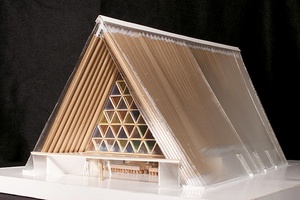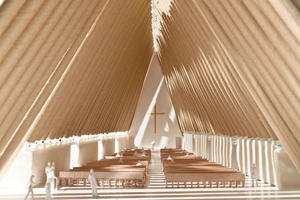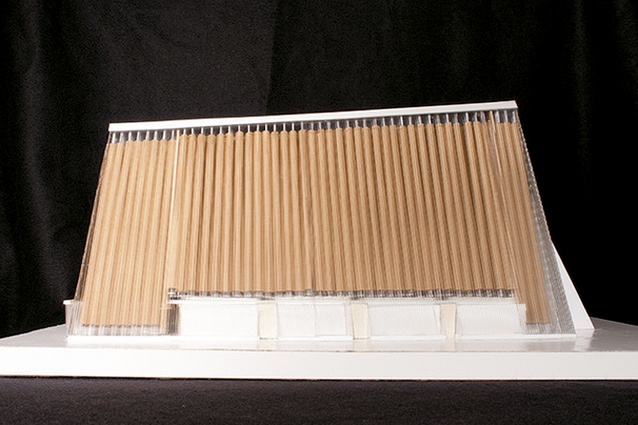Christchurch architectural notes
Six months on from the 22 February 2011 Christchurch earthquake, the city and its citizens have started on the long transition from loss to recuperation. The process of recovery speaks volumes about current political, social and cultural values, values that can be reflected by and expressed in architecture and attitudes to the built environment. In architectural terms the losses are hugely significant: hundreds of the city’s architectural gems from throughout its 160 years of organised settlement and urban development have been, or will soon be, demolished. Recuperation of buildings and public spaces is, at this point, still largely conceptual, expressed in words and drawings.
Full and final responsibility for the city’s recovery and rebuilding lies with the Canterbury Earthquake Recovery Minister Gerry Brownlee, who holds extraordinary coercive powers under the Canterbury Earthquake Recovery Act, passed on 12 April 2011. The same legislation established the Canterbury Earthquake Recovery Authority (CERA) to coordinate recovery, as it was deemed beyond the capacity of existing institutions. For much of the past six months CERA and the minister have been the key decision-makers over the shape of human space in Christchurch. Most of their decisions have been about emptying occupied space: an estimated 50 percent of central-city buildings are to be demolished and, to date, the government has decided over six thousand residential properties in Christchurch and the neighbouring Waimakariri district will be abandoned. Many thousands of households in the residential “orange” and “white” zones are still waiting for news about the future of their land and properties.
The rapid, nearly eager, demolition of significant pieces of Christchurch architecture since 22 February 2011 is not a simple equation that reflects merely the severity of the damage or the unquestionable necessity of ensuring our built environment is safe. It also represents the weak political interest in recognising or protecting the cultural values made tangible through architecture.

To anyone who understands the complex interactions that determine how cities function and develop, the act’s division of responsibility for the city’s recovery fails to make sense. It artificially severs planning of the central city within the four avenues from the ongoing development of the surrounding suburban periphery, as if the two were mutually exclusive. This is particularly keenly felt in a city that has for many years suffered the effects of a retail commercial drift to the suburbs. The Christchurch City Council’s ambitious draft recovery plan for the hard-hit central city, released prematurely on 11 August 2011, quietly attempts to straddle this division by proposing a five-year restriction on suburban commercial development.
The draft central city plan is bold in scope and vision. Following on from a six-week, multi-platform public consultation process, the plan was produced by council and contracted staff, including Gehl Architects and Boffa Miskell. Volume one is the public-friendly focus of the plan and outlines over seventy projects for the rebuilding of the city, including the creation of new public spaces, new public buildings and facilities, new and altered infrastructure developments and recognised character areas or new precincts. The major new public space is the Avon River Park, a widened riverside corridor within the four avenues, with closed roads or reduced traffic. Other new spaces comprise a series of neighbourhood parks joined by green pedestrian and cycle corridors and a yet-unidentified space for an earthquake memorial. The major infrastructural development is the proposed introduction of the first stage of a light-rail network linking the central city to the university and with later stages extending to the airport and key suburban hubs.
There are plenty of landmark architectural opportunities in the proposed new public buildings and facilities. These include a larger central library (suggesting the possible demolition of Warren and Mahoney’s 1982 Central Public Library), a new convention centre (with the expected demolition of the 1997 building designed by Thom Craig and Warren and Mahoney), a Metro Sports hub (to replace the facilities lost in the likely demolition of Peter Beaven’s 1971–73 QEII Park in New Brighton), a developed hospital complex, a new mid-sized performing arts centre, a new professional theatre to house the Court Theatre, and the EPI-Centre, a proposed national earthquake research, museum and education institute.
The plan rezones the central city with corresponding new height and facade restrictions to create a fairly consistent low-rise urban form. This has, unsurprisingly, already caused a stir. It reduces, intensifies and defines the central-city zone and the rigour of the street grid. Building right to the front is a requirement of most new buildings. Compulsory heights of between 13 and 29 metres are set in the core zone, and between 9 and 21 metres in the fringe, with setbacks and corresponding maximum “facade” heights of 21 and 17 metres respectively. It suggests wider values than unfettered pursuit of return-per-square-metre should be at play here.
As ever, translating a bold vision and laudable desire for good urban and architectural design into council rules and regulations is sticky, problematic and, here, unsuccessful. The legislation gave the council a tight timeframe to deliver the plan. Four planners are said to have translated the grand vision of the plan into a regulatory framework within five weeks. It shows. Good design is reduced to regulating active street frontages and increasing public safety via ratios of solid to glazed wall surfaces on all storeys, inserting pedestrian entrances every ten metres, requiring materials and colours to complement neighbouring buildings, making use of horizontal lines to define a base, middle and top, and using vertical lines to “reinforce historic plot boundaries or create strong vertical rhythm.” Flat roofs must be bad, as pitched roofs between fifteen and sixty degrees are rewarded with an extra height allowance. There is a genuine effort to accelerate sustainable design and building practices, yet it all rests on demonstrating enhanced environmental performance by passing the NZ Green Building Council’s new Building Green Christchurch Tool rating. Christchurch’s recovery would be better served had the council decided to divert more energy from the seductions of volume one into unsexy, stolid volume two of the plan, as this section is going to be hugely significant in the design outcomes of the city.
While the focus of earthquake recovery has been on the central city, a design-led community initiative has cropped up in suburban Sumner, with architectural graduates, architects and designers investing volunteer hours in producing urban design strategies for the rebuilding and improvement of the seaside village. Masterplanning of hard-hit, less affluent suburban hubs like Sydenham, Lyttelton, Linwood Village and the Selwyn Street shops are council-led processes with contracted design practice Urbanismplus working on plans for Sydenham and Lyttelton. Unsurprisingly, early indications suggest greater community involvement and higher community expectations and organisation are providing stronger outcomes.
Meanwhile, the value of temporary architectural solutions in the rebuilding of Christchurch is being explored on humble and grand scales across a variety of building types. Contracts to supply temporary residential accommodation to the Department of Building and Housing to re-house displaced residents in Kaiapoi, Linwood and New Brighton have resulted in perfunctory, clumsy and, for renters, comparatively expensive one-, two-, three- and four-bedroom units which contrast poorly with the design-led initiatives for temporary housing arising in Japan after the 11 March 2011 earthquake and tsunami.
The Restart the Heart project aims to reopen the west end of Cashel Mall using the internationally ubiquitous proprietary unit of the shipping container as temporary retail and entertainment facilities with designs by the Buchan Group. The results are determinedly bright and shiny, a truly pop pop-up venture. By contrast, the Christchurch Polytechnic Institute of Technology is exploring the potential of purpose-designed, locally manufactured, temporary, transportable modular units for use as gallery and design retail space. These will be leased at peppercorn rentals to local artists and design practitioners. Developed by F3 Design, the steel, timber and polycarbonate modules are highly adaptable and provide greater spatial variation and architectural richness. The modules have a potential afterlife and can be subsequently absorbed into a new permanent building.
The most exciting and moving temporary project on the horizon in Christchurch is Japanese architect Shigeru Ban’s Cardboard Cathedral. The Anglican Diocese approached Ban to design a temporary building a member of the cathedral staff read about the work of the “emergency architect.” Ban agreed to conceive and complete the design work at no cost. Using his customary vocabulary of paper tubes, shipping containers and polycarbonate, Ban’s design is a huge pitched roof form that tapers toward the east end. In an effort to respect the past, the form and dimensions are based on Ban’s geometric abstractions of the west and east elevations and plan of George Gilbert Scott’s severely damaged Christchurch Cathedral (1863–1904). The inspiration for the design and colours of the polycarbonatefilled west end are drawn from the collapsed rose window of the original cathedral. The form also recalls the temporary V-shaped huts built in Hagley Park by Canterbury Association settlers in the 1850s.

The Dean of the Cathedral, Peter Beck, finds a strong correlation between Ban’s design and Christian theology and values. He cites the design’s sustainability, the potential of the collaborative community-based construction process and the role of architectural beauty in spiritual transformation as vital elements of a place of Christian worship in the twenty-first century. In addition to cathedral services, the building will provide a community and civic gathering place for up to seven hundred people. The fourmillion- dollar project has received funding for a feasibility study from the Christchurch Earthquake Appeal Fund. Sites on existing Anglican land in the central city are being assessed and the architect and his client hope to open the Cardboard Cathedral on 22 February 2012, the first-year anniversary of the Christchurch earthquake.
Notable permanent rebuilding is slow to start, with refinancing and liability insurance causing delays. Belying his age and the drastic damage to his historic home in September 2010, Sir Miles Warren has set about rebuilding Ohinetahi in Governors Bay. The ground floor of the original stone section has been rebuilt in the original material, though it is now strengthened with a concrete shear wall. The first floor is being rebuilt to a new timber design by Warren, with stone window surrounds, dormer windows and a hipped roof replacing the 1860s first floor and twin-gabled attic stone central section. The remaining original fabric has been incorporated into a stone amphitheatre within the grounds.
Few other damaged heritage buildings are being treated so optimistically. Painstaking work at the Cathedral of the Blessed Sacrament leaves the question of reconstruction open but as yet unanswered. Teams of engineers, heritage consultants, architects and dismantlers are slowly taking FW Petre’s celebrated building apart and using innovative engineering solutions to prop some sections. All but one building at the Arts Centre, the Gothic Revival former Canterbury College site, are closed for an unknown period to allow for remediation, repair and strengthening work. As ever, the matter of retaining and strengthening heritage buildings is not one of whether it can be done but having the will and money to do it. The government has not increased its dollar-for-dollar support of heritage since the September earthquake. The CCC’s draft central-city plan promises an increase in heritage funding and support. By the time the plan comes into effect, will it be too late?
The value put on heritage is just one measure of the ideological chasm between central and local government in their approaches to the rebuilding of Christchurch. Even if lacking in regulatory effectiveness, the draft centralcity plan speaks of the council’s interventionist, visionary leadership for the city. It includes radical suggestions such as rebuilding assistance and social housing for low- and middle-income families purchasing inner-city residences. The minister met the draft plan with a characteristically dampening response, calling it a “pretty big wish list.” Central government’s faith in market forces to secure the future of a city shattered by natural disaster indicates that it is up to Christchurch’s citizens, architects, institutions and civic representatives to demand and craft an interesting and considered built environment.










